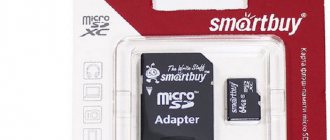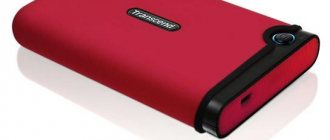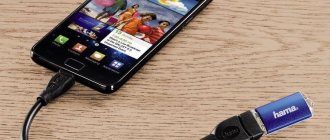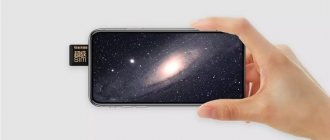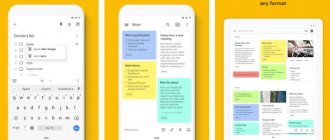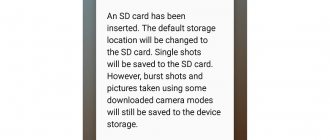Freeing up useful space on your Xiaomi - how to transfer data and applications to an SD card?
Recently, the issue of storage capacity is no longer as pressing as it was before. Literally 5 years ago, the gold standard for budget devices was 32 GB, of which a few more “gigs” were allocated for the system, and larger volumes remained the prerogative of flagship devices. Today, many mid-budgeters offer 128 GB in the “base”, and some offer all 256 GB in the maximum configuration.
Our beloved Xiaomi not only keeps up with this trend, but often sets it. However, the Chinese company, for now, does not forget about those who like to save money and leaves the opportunity to buy a budget phone with a 64 or even 32 GB drive. In this case, the buyer may wonder how to preserve his modest memory reserves while using the device without denying himself anything.
A memory card comes to the rescue - a micro-SD drive, the slot for which can still be found in the vast majority of devices from the Chinese brand. Contrary to the opinion that a flash card can only store multimedia files (music, photos, videos), Xiaomi gave the user the opportunity to transfer some of the existing applications in order to facilitate the work of the internal storage. Today we will figure out how to transfer applications to an SD card in Xiaomi smartphones.
Transfer apps to SD card without using PC
First, let's look at the simplest ways to transfer applications to a memory card, and leave the hard stuff for later. Suddenly, all subsequent manipulations will take place on your device without errors, and you will not observe any problems in the operation of the device.
It’s worth mentioning right away that all manipulations are best done with a high-quality and definitely not the cheapest micro-SD card. Before buying a new memory card, pay attention to reviews - it is better to choose already trusted manufacturers. It is also important to note that today memory cards are equipped with a quality class mark. You should concentrate your attention on components of at least class 10 - this mark is usually right on the front of the package.
And, of course, don’t forget to create a backup copy of your settings so that if unplanned errors occur, you can return to their original state.
So, we’ve done the preparatory steps, let’s move on to the data transfer itself.
Activity Launcher
To easily transfer data without using your computer, the Activity Launcher application will help us. This application has long been familiar to all fans of “digging” into the system of their Xiaomi device. The application is publicly available on the Google Play Store, so you don’t have to search for it for a long time - just enter the name of the program into the Google Store search and install it on your smartphone.
The Activity Launcher application is useful for many things, but in our case it will serve as a kind of bridge between the general device settings and your SD card. Simply put, the application provides access to functions that, for one reason or another, were hidden to the average user.
Back in MIUI 9, Xiaomi offered the user to transfer any data they wanted to the SD card, including applications, and, as you can understand, this could be done directly in the device settings without those very “dances with a tambourine.” Already in version 10 of MIUI, the manufacturer decided to hide this function, without much explanation.
One can wonder for a long time what prompted Xiaomi to make such a decision, but there is one very plausible solution to this riddle circulating on the Internet - the company decided not to delay the transition to more capacious internal storage drives, and the ability to free up space on your smartphone using an SD card was greatly slowed down this transition. Whether this is true or not, only Lei Jun, the chief director of Xiaomi, can answer.
Using Activity Launcher to Move Apps to SD Card
Now we will consider in detail all the steps to transfer applications to a memory card without using a computer. We go to the already installed Activity Launcher application and look for the “ Recent actions ” item at the top of the list. There, on it and inside, select the sub-item “All actions”. At this moment, all processes and applications on your smartphone will begin loading. You won't have to wait long - downloading usually takes less than one minute. After downloading, look for the “ Documents ” item, click on it and observe the appearance of a new menu, in which we find the line “Downloads: com.android.documentsui.LauncherActivity”.
Click on this line and go to a new page. In the left side menu of this page, look for the “ SD card ” item, click on it, and then click on the “ellipsis”. This symbol gives us the opportunity to select the “ Memory ” item, which, in turn, takes us to the advanced storage settings of your device, and since we previously selected the “ SD card ” item, obviously, the memory card settings are considered next.
In the new storage settings window, scroll to the end and find the “ Internal memory ” - click on it. Next, a warning will appear on the smartphone screen stating that the storage memory will be formatted - we agree by clicking on “Clear and format”. After this procedure, you will be able to install applications on your SD card.
The move itself is very simple. Exit Activity Launcher and go to general Settings . Scroll down to “ All applications ”. Inside this section, we look for applications that you would like to transfer (for example, “heavy” games), click on the application and find the “ Storage ” item inside. Inside this section, look for “ External storage ”, click on it and agree to the transfer. Ready.
What to do if Xiaomi does not see the memory card?
Xiaomi does not see the memory card (flash drive). What should I do?
- Make sure the memory card is inserted correctly
- Reboot your device
- Lack of support for some memory cards
- The card is full
- Format the memory card
- Viruses on a smartphone
Interesting materials:
How to bookmark a site in Safari? How to add a font to PocketBook? How to add a slide to a powerpoint presentation? How to add light to a room? How to add your music to VK history? How to add padding polyester to a jacket? How to add an OKVED type of activity? How to add a second iCloud account? How to get to Zhukovsky airport by public transport? How to get to ap zhukovsky?
Outdated transfer methods without a computer
The following methods for transferring applications from internal storage to an SD card cannot be considered relevant for recent Xiaomi products. But if you have an old device from a Chinese company and you need to “refresh” its internal memory a little, then some programs that were popular in the past will come to your aid.
First, you need to check if your smartphone allows you to transfer app data. To do this, go to general Settings and look for the “ All applications ” item. Tap on any application that is important to you and check if there is a “ Transfer to SD ” icon in the list of application settings. If it is in place, then you can confidently start transferring applications to the SD card. Several applications will help you with this.
Link2SD
The application is very easy to use and is also easy to find on the Google Play Store. We install, go to the main screen, select the application we need, click on it and select “Move to SD card” from the available options. We go through this process with each application we need. Important note: ROOT rights are required to work with the program.
AppMgr III (App 2 SD)
If your smartphone is not rooted, we recommend that you pay attention to the AppMgr III application. It has the same simple interface, perhaps even simpler. To move, you just need to perform a swipe gesture from left to right - a list of available actions will appear. In it, select the “Move” item, agree to the transfer by clicking “OK”.
Clean Master
Few people know, but the super-popular solution for cleaning a smartphone also has the functionality of transferring applications from a smartphone to a memory card. To “transfer” programs, find the “ Application Manager ” item on the Clean Master main screen, click on it, go to the list of all applications and check off all the programs necessary for transferring. After that, we need to click on the blue button located at the bottom of the screen - done. The only negative is that this method does not work on every device, and you only need to rely on luck.
FolderMount
Another application that requires the use of root rights. Also, the interface cannot be called friendly - to transfer programs you will have to go through a bit of a thorny path. But you are guaranteed a huge plus in the form of almost problem-free “shifting” of applications to the SD card memory.
We start by opening the application - the first thing we are greeted with is the phrase “ There is no list of pairs .” We “swipe” from left to right and see the settings menu, among which we find the “ Application Analyzer ” item. We click on it - two windows are displayed in front of us: “ data ” and “obb”.
We tap on the “ Create a pair ” icon and observe the appearance of a new “ Folder Options ” window, inside which will be the following information: file name, application source and destination (that is, the location where the application will be moved).
Select the file location you need and agree to the transfer by clicking on the checkmark at the top of the screen. The transfer will begin, after which you will need to go to the main FolderMount window and enable the slider between the application and the moved folder in the SD card.
Transferring applications using a computer
So, now we’ve dealt with the simplest methods, now it’s time for the “heavy artillery”. As is usually the case, the most complicated actions presuppose the most acceptable and effective result. The same thing awaits us as a result of carrying out all the steps in the next method of transferring applications to an SD card.
As you can understand from the subtitle of this section of our instructions, this algorithm for transferring applications involves using a computer, as well as downloading additional files. But first things first.
First of all, you will need to download a script called aftiss_b2 - it can be found at this link. Unpack the files from this archive onto the desktop of your PC.
Next, you will need the developer settings for your smartphone. By the way, we recently talked about them in this article. Go to the advanced settings and enable USB Debugging, and also activate the “ Allow saving to external drives ” option. After this, you will need to format your SD card - it is best to do this also through a PC. When the card is formatted, insert it into the smartphone.
Next, you need to connect your smartphone to your computer. When the PC recognizes the smartphone and a window for selecting an action appears on the screen (on the smartphone it will be written “USB operating mode”) with your phone, you will need to select the “ File transfer ” item. Only after this you will need to open the aftiss_b2 for the command line to start.
Please note that you will see a list of available SD card formatting options: 25%, 50%, 75% and your percentage. Experienced users advise choosing item “2” - 50 percent. After you click on the number you need, the process of formatting the memory card starts, after which the message Done will appear. All is ready! You will now be able to see the increased amount of memory inside your phone.
Script aftiss_b2
Let's directly transfer data from the internal drive to the external one. For this we will need the Activity Launcher again. Open the application, click on the “Last actions” item and select “ All actions ” - wait for it to load. After that, look for the “ Settings ” section, click on it and look for the “ All applications ” section among the sub-items that open.
Important note - we need an item that is located ABOVE the “All applications” section WITHOUT an icon.
In the window that opens, find the “ Mi Community ” application and click on it. Inside we will find advanced settings of this program - we need to click on the “ Storage ” item.
If everything is done correctly, you should observe the “ Change ” sub-item.
Click on it and at the bottom click on the “ SD card ” button. After this, we will need to click on the “ Move ” button, which will appear in the new window that opens.
Again, if everything goes without problems, then all subsequent applications will be installed directly on your SD card.
Important nuances of the procedure
When using any of the following transfer methods, consider the following:
- The speed of programs and games on some memory cards is lower than on internal memory. Therefore, to eliminate possible errors, it is recommended to use an SD card of class 10 or higher.
- Sometimes desktop icons may disappear or move after moving programs and games. To prevent this, it is recommended to activate the “Protection against changes” option in the desktop settings in advance.
- “Storage” may not display the actual amount of memory.
Return to original state
If you need to return your smartphone to its usual state (that is, again use the memory card only as a “file dump”), then this will be much easier to do than expanding the internal memory using this very card.
First, we transfer all the applications we need back to the phone’s memory - you just need to go to the device settings, “All applications” and select the internal drive in the “ Change ” storage item. After this, we restart the smartphone and check that all applications are working properly.
Next, you will need to go to the general Settings of the device and find the “ Storage ” item. Inside this item there will be a “ Clear SD card ” button waiting for you - click on it. After this, we wait for the card to be formatted, wait for it to finish and reboot the smartphone again. Done - the card works as its manufacturer intended.
As we can see, despite noticeable restrictions on the part of Xiaomi, craftsmen can still help solve even the most confusing requests of fans of the Chinese brand. We hope that this instruction was useful to you too.
Frequently asked questions and problem solving
- Is it possible to use memory cards with low speed. It is possible, but in this case the applications will be unstable, constantly crash, glitch, and so on. If you use a card from Chinese nonames, the phone may stop seeing it altogether.
- Is root required? It all depends on which application to use. But it is worth noting that programs with superuser rights are better at transferring applications.
- Link2SD does not work on the phone. Before using the program, you need to root your smartphone.
- After the transfer, the phone froze tightly and does not respond to anything. A low-quality flash drive was probably used. You need to remove the external drive and reboot the phone. If that doesn't help, reset it to factory settings.
- Some apps won't move. You are probably trying to transfer MIUI system apps. This is impossible to do.
- Why doesn't MIUI have native portability? Because this is the desire of the Xiaomi company. If such a function existed, then no one would buy phones with large storage capacities.
